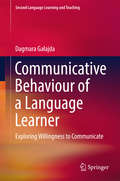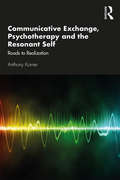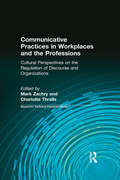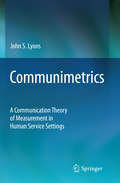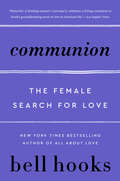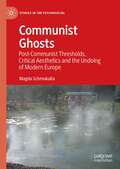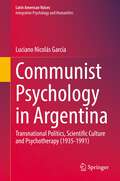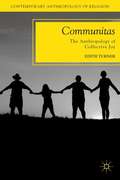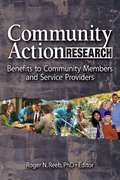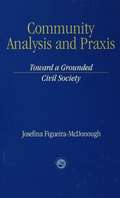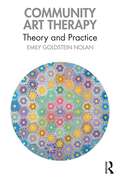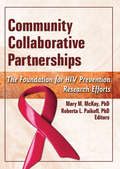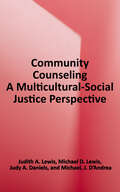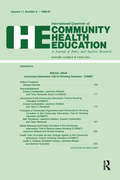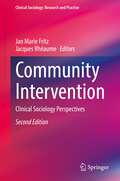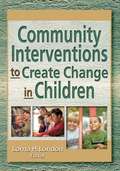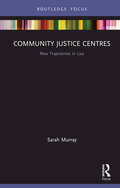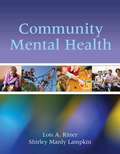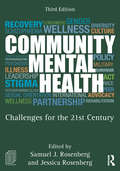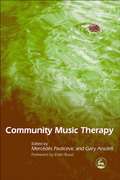- Table View
- List View
Communication: The Social Matrix of Psychiatry
by Gene Combs Gregory Bateson Jurgen Ruesch Eve C. PinskerThe integration of psychiatry into the mainstream of American society following World War II involved rethinking and revision of psychiatric theories. While in the past, theories of personality had been concerned with the single individual, this pioneering volume argues that such theories are of little use. Instead, the individual must be seen in the context of social situations in which rapid advances in communication technology have brought people closer together, changing their behavior and self-expression. Ruesch and Bateson show that following World War II mass communication and culture have become so pervasive that no individual or group can escape their influences for long. Therefore, they argue that processes of psychoanalysis must now consider the individual within the framework of a social situation. Focusing upon the larger societal systems, of which both psychiatrist and patient are an integral part, they develop concepts that encompass large-scale events as well as happenings of an individual nature. They have outlined this relationship in a unified theory of communication, which encompasses events linking individual to individual, individual to the group, and ultimately, to events of worldwide concern. The term "social matrix," then, refers to a larger scientific system, of which both the psychiatrist and the patient are integral parts. Jurgen Ruesch was professor of psychiatry at the University of California School of Medicine and director of the section of Social Psychiatry at the Langley Porter Neuropsychatric Institute in San Francisco. Gregory Bateson taught at Columbia University, the New School for Social Research, Harvard University, Stanford University, and the University of California, Santa Cruz. Among his books are "Naven", "Steps to an Ecology of Mind, Mind and Nature: A Necessary Unity", "Angels Fear: Towards an Epistemology of the Sacred", and "A Sacred Unity: Further Steps to an Ecology of Mind".
Communicative Action: Selected Papers of the 2013 IEAS Conference on Language and Action
by Tzu-Wei HungThis book focuses on the connection between action and verbal communication, exploring topics such as the mechanisms of language processing, action processing, voluntary and involuntary actions, knowledge of language and assertion. Communication modelling and aspects of communicative actions are considered, along with cognitive requirements for nonverbal and verbal communicative action. Contributions from expert authors are organised into three parts in this book, focussing on language in communication, action and bodily awareness and sensorimotor interaction and language acquisition. Readers will discover various methods that have been employed in investigations presented here, including neurological experiment, computational modeling and logical and philosophical analysis. These diverse expert perspectives shed light on the extent to which a mechanism for processing actions also facilitates the processing of language and the authors' work prompts further interdisciplinary investigation of the relationship between language and action. This book is written for readers from different academic backgrounds; from graduate students to established academics in disciplines ranging from neuroscience to psychology, philosophy, linguistics and beyond. Earlier versions of the selected essays in this book were presented at the 2013 IEAS Conference on Language and Action, held in Taipei, Taiwan.
Communicative Behaviour of a Language Learner: Exploring Willingness to Communicate (Second Language Learning and Teaching)
by Dagmara GałajdaThis book investigates and analyzes the way in which factors such as communication apprehension, self-perceived communicative competence and group dynamics influence the communicative behavior of a foreign-language learner. It also focuses on interpersonal communication, group communication and public speaking. Using selected models it characterizes and analyzes all types of communication with reference to communication in the language classroom, with a particular emphasis on the foreign-language context. The author also presents some conclusions and implications for both language teachers and language learners, as well as offering suggestions for further research in the field of classroom communication. The results of the study serve as a point of reference for teachers interested in the construct of willingness to communicate and other communication variables related to the issue of communication in a foreign language. The work also raises teachers' awareness of individual learner differences in the context of communication in the foreign-language classroom.
Communicative Exchange, Psychotherapy and the Resonant Self: Roads to Realization
by Anthony KornerIn Communicative Exchange, Psychotherapy and the Resonant Self, Anthony Korner demonstrates how important communication and resonance are to the development of a sense of self. This process of realization is embedded in social relatedness and is intrinsically tied to language. Uniquely presenting a collaborative approach to research, this book illuminates the potential for change that lies in therapy that engages both heart and mind between patient and therapist, as well as demonstrating how language and relating are fundamental to psychotherapy. Korner explains how language engenders growth through communicative processes that shape lives and personality. Korner helps the reader see how communicative exchanges can be transformative. Brimmed with emotive clinical material, literary illustrations and reports of first-hand life experience, Korner demonstrates how the combination of knowledge and evocation of feeling in human connection is central to psychotherapeutic process. An intersubjective approach to research is put forward as exemplar of how the minds of both patient and therapist might be employed in furthering understanding of psychotherapeutic process. This book will be an essential resource for mental health clinicians involved in psychodynamic psychotherapy, as well as more generally to people interested in understanding human connections.
Communicative Practices in Workplaces and the Professions: Cultural Perspectives on the Regulation of Discourse and Organizations (Baywood's Technical Communications)
by Mark Zachry and Charlotte ThrallsBringing together prominent scholars from a variety of disciplines, "Communicative Practices in Workplaces and the Professions: Cultural Perspectives on the Regulation of Discourse and Organizations" offers readers an engaging set of essays on the complicated relationship between discourse and the many institutions within which people act. Each author brings a unique theoretical perspective to conceptualizing how discourse is regulated and how it regulates when human activity is organized for such purposes as work or belonging to a profession. Together, the contributors to this collection offer a provocatively complex picture of what regulation means and the means of regulation.
Communimetrics: A Communication Theory of Measurement in Human Service Settings
by John S. LyonsMeasurement in human services means one thing: how well the effort serves clients. But the data doesn't exist in a vacuum and must be communicated clearly between provider and client, provider and management, and across systems. During the past decade, innovative communimetric measures have helped more than 50,000 professionals worldwide in health care, justice, and business settings deliver findings that enhance communication on all sides. Now, the theory and methods behind this fast-paced innovation are available in this informative volume. Communimetrics presents information in an accessible style, and its model of measurement as communication bolsters transparency and ease of interpretation without sacrificing validity or reliability. It conveys a deep appreciation for the unique position of service delivery systems at the intersection between science and management (and between quality and quantity), and shows readers how to create measures that can be used immediately to translate findings into practical action. This must-have volume offers readers the tools for understanding--and applying--this cutting-edge innovation by providing: The theoretical base for communimetrics. Practical illustrations comparing communimetrics with traditional methods. Guidelines for designing communimetric measures and evaluating their reliability and validity. Detailed examples of three widely used communimetric measures--the Child and Adolescent Needs and Strengths (CANS), the INTERMED, and the Entrepreneurial League System Assessment as well as detailed explanations for how they are used and why they work. Applications used in a range of settings, including children's services, adult mental health, services for the aging, and business and organizational development. Communimetrics provides a wealth of real-world uses to a wide professional audience, including program evaluators, quality management professionals, enterprise managers, teachers of field research methods, and professionals involved in measurement and management design. It also makes an exceptionally useful text for program evaluation courses.
Communion: The Female Search for Love (Love Song to the Nation)
by bell hooksRenowned visionary and theorist bell hooks began her exploration of the meaning of love in American culture with the critically acclaimed bestseller All About Love: New Visions. She continued her national dialogue with the bestselling Salvation: Black People and Love. Now hooks culminates her triumphant trilogy of love with Communion: The Female Search for Love.Intimate, revealing, provocative, Communion challenges every woman to courageously claim the search for love as the heroic journey we must all choose to be truly free. In her trademark commanding and lucid language, hooks explores the ways ideas about women and love were changed by the feminist movement, by women's full participation in the workforce, and by the culture of self-help.Communion is the heart-to-heart talk every woman -- mother, daughter, friend, and lover -- needs to have.
Communist Ghosts: Post-Communist Thresholds, Critical Aesthetics and the Undoing of Modern Europe (Studies in the Psychosocial)
by Magda SchmukallaThis book explores post-communist thresholds as materializations of a specific crisis of modern European identity that was caused by the existence and sudden breakdown of Soviet-type communism. It shows how post-communist thresholds emerge where relics from the communist experience continue disrupting the routines and rhythms of a modern life and confront Europeans with cultural experiences, affects and material realities of the ‘enlightened world’ which they usually seek to repress or ignore. In exploring and writing through art projects which engage with the psychosocial fabric of such post-communist thresholds, this book finds ways of speaking and thinking through these transitory and paradox sites, and asks what we can say about other or new worlds, about new beginnings and endings as well as about decolonial and ethical ways of relating to the other when assessing the status quo of European modernity from within its liminal and crisis-driven sphere.
Communist Psychology in Argentina: Transnational Politics, Scientific Culture and Psychotherapy (1935-1991) (Latin American Voices)
by Luciano Nicolás GarcíaThis book presents an intellectual history of the reception of Soviet psychology in Argentina as part of the communist scientific culture promoted by the Argentine Communist Party. This research reconstructs the material conditions, the political conjunctures and disciplinary disputes that allowed the international circulation of the works and ideas of Ivan Pavlov and Lev Vygotsky, and analyzes how pavlovism and vygotskianism impacted psychology, psychiatry and the wider mental health field in Argentina between 1935 and 1991.Starting on the 1930s, a group of professionals, scientists and intellectuals who belonged to the Argentine Communist Party introduced Soviet psychology in Argentina as an effort to promote the philosophical and political principles of Marxism-Leninism in Argentinean psychological and psychiatric academic circles, as well as in mental health institutions. This book shows how the efforts of this group contributed to the diffusion of communist scientific ideas and practices in South America as part of a transnational circuit of communist scholars and intellectuals that included France, Spain and the USA, which fostered scientific exchange and politicized science during the years of antifascist struggle and the Cold War. Communist Psychology in Argentina: Transnational Politics, Scientific Culture and Psychotherapy (1935-1991) will be of interest to historians of psychology and psychiatry concerned with the study of the relationship between Marxism and psychology in the 20th century, as well as to historians of science in general attentive to the study of the circulation of scientific ideas, as the book reconstructs the networks of the international communist movement as an effort to provide a scientific basis for the development of a socialist program in different parts of the world.
Communitas
by Edith TurnerCommunitas is inspired fellowship; a group's pleasure in sharing common experiences; being 'in the zone' - as in music, sport, and work; the sense felt by a group when their life together takes on full meaning. The experience of communitas, almost beyond strict definition and with almost endless variations, often appears unexpectedly.
Community Action Research: Benefits to Community Members and Service Providers
by Roger N. ReebDiscover how to better help those in your community in need of servicesCommunity Action Research comprehensively explores models for community action research, incorporating quantitative and qualitative research to highlight the advantages to community members as well as the volunteers/paraprofessionals who implement the services. Respected experts present the latest research on the fulfillment of the needs of community members as well as the benefits to the volunteers and paraprofessionals, including psychological empowerment, psychological sense of community, and other facets of personal development.Community Action Research is helpfully organized into two sections. The first section presents a sample of empirical studies that examines whether community action research demonstrated benefits for community members. The second section provides empirical studies that show the positive impact of community action research on the personal development of volunteers and paraprofessionals who provided the research-related services. This detailed text is carefully referenced and uses several tables to enhance understanding of research data. Community Action Research discusses: the Adolescent Diversion Project as an alternative to juvenile court home-based behavior modification programs for autistic children the People Awakening Project and the role paraprofessionals played in Alaska Native sobriety a crime prevention project launched by a residential neighborhood association the Actual Community Empowerment Reading Program which utilized community members as literacy tutors the Community Service Self-Efficacy Scale&’s reliability and validity the Hawaiian Studies Program&’s weekly participation in community service-learning exercises and more!Community Action Research is insightful reading for psychologists, sociologists, social workers, criminal justice researchers and professionals, community counselors, practitioners and researchers in community prevention and intervention, clinical supervisors, service learning specialists, educators, students, and mental health and human services program administrators, planners, or evaluators.
Community Analysis and Practice: Toward a Grounded Civil Society
by Josefina Figueira-McDonoughConcentrating on three main themes - environmental complexity, community as the target of intervention, and commitment to social justice - Community Theory and Practice updates and expands the current boundaries of thinking about community organization. This book is an important resource for social work students, educators, and practitioners, as well as those who work in the areas of sociology, urban studies, community organization and development, and criminology, and other areas of social study and policy.
Community Art Therapy: Theory and Practice
by Emily Goldstein NolanThis book provides a narrative exploration of community art therapy woven from its rich practice roots, theory, the multiple ways that it can be applied in practice, and through practitioner reflections. The applications of community art therapy are numerous, and this book provides knowledge to practitioners, guiding them in their own work and grounding their theoretical approaches. The community approaches presented in the text have been developed through careful research, strategy, and implementation. Community Art Therapy is for the benefit of art therapists, community artists and psychologists, and anyone interested in learning more about the stories of community art therapy.
Community Collaborative Partnerships: The Foundation for HIV Prevention Research Efforts
by Mary M. Mckay Roberta L. PaikoffFind out how best to develop HIV prevention programs that workCommunity Collaborative Partnerships: The Foundation for HIV Prevention Research Efforts is a must read for anyone interested in developing prevention programs within high-risk urban environments. Illustrative case studies, quality research, revealing personal stories, and helpful tables and figures provide valuable insights on innovative ways to partner in the prevention of the spread of HIV in youths. Leading experts in the field offer practical strategies to dissolve the distrust individuals in a community hold for researchers not a part of that community, fostering an effective collaboration to deal with problems. The book also describes ways to go beyond the United States&’ model to reveal how to replicate the same dynamic relationships in international communities.Active participation with the community and families has been found to be vital for the success of HIV/AIDS prevention efforts. Community Collaborative Partnerships: The Foundation for HIV Prevention Research Efforts solves the common problem of forcing ineffective program models onto an unreceptive community. Program developers get the necessary tools to develop relationships and cultivate substantive input from those in the community to help ensure better program results. The research here is up-to-date, and the suggestions invaluable.Topics in Community Collaborative Partnerships: The Foundation for HIV Prevention Research Efforts include: the role of parenting in mental health and HIV risk research findings about frequency of sexual intercourse among adolescents racial socialization and family role in HIV knowledge family influences on exposure to situations of sexual possibility preadolescent risk behavior influence on parental monitoring strategies for collaboration between community and academic HIV prevention researchers involving urban parents as collaborators in HIV prevention research motivators-and barriers-to participation of minority families in a prevention program transferring a university-led HIV prevention program to the community Trinidad and Tobago HIV/AIDS prevention using a family-based program and much more!Community Collaborative Partnerships: The Foundation for HIV Prevention Research Efforts is valuable reading for researchers, program developers, community-based organizations, public policy/advocacy organizations, community organizers, educators, and students in the fields of social work, public health, public administration, and community medicine.
Community Counseling: A Multicultural-Social Justice Perspective
by Judith A. Lewis Michael D. Lewis Judy A. Daniels And Michael J. D’AndreaThis book clearly describes and illustrates the practice of community counseling by discussing the most current issues and practices for community work in the 21st century. <p><p>The Fourth Edition gives special emphasis to the practices of diversity, ethics, and the role of the counselor as a change agent and advocate. Focusing on how to promote change and growth, the text delivers effective guidelines for planning and implementing productive community counseling programs. It also provides readers with a basic understanding of the role of the community counselor, the services offered by community agencies, and the settings in which they are offered.
Community Disaster Vulnerability: Theory, Research, and Practice
by David F. Gillespie Michael J. ZakourDisaster vulnerability is rapidly increasing on a global scale, particularly for those populations which are the historical clients of the social work profession. These populations include the very young and very old, the poor, ethnic and racial minorities, and those with physical or mental disabilities. Social workers are increasingly providing services in disasters during response and recovery periods, and are using community interventions to reduce disaster vulnerability. There is a need for a cogent theory of vulnerability and research that addresses improved community disaster practice and community resilience. Community Disaster Vulnerability and Resilience provides a unifying theoretical framework backed by research which can be translated into knowledge for effective practice in disasters.
Community Health Psychology: Empowerment for Diverse Communities
by Jean Lau Chin Victor De La Cancela Yvonne JenkinsAs the number of people of color rapidly grows within the US population, health providers in these communities have become increasingly aware of the need to address the concerns and problems particular to each group. It's also become clear that as the delivery of our health care systems evolve, a new approach must be summoned to build systems both cost-effective and socially responsible.Community Health Psychology offers a new and different perspective for redressing the gaps in our systems of care. The authors contend that in order to begin an attempt at eradicating the more intractable societal problems, health providers need to tailor themselves to a more culturally competent approach, which addresses all members of a community they claim to serve.
Community Intervention Trial for Smoking Cessation: COMMIT
by Edward Lichtenstein Lawrence M Wallack Terry PechacekThe Community Intervention Trial for smoking cessation (COMMIT) is sponsored by the National Cancer Institute and involves eleven pairs of communities in North America. COMMIT emphasizes a partnership between the eleven research institutions and their respective intervention communities in developing the structures needed to implement the intervention protocol. We summarize the epidemiological data and describe the prior community interventions that set the stage for COMMIT, and discuss how COMMIT may inform state-wide tobacco reduction demonstration programs. An overview of the articles that describe the COMMIT intervention and evaluation plan is presented.
Community Intervention: Clinical Sociology Perspectives (Clinical Sociology: Research and Practice)
by Jan Marie Fritz Jacques RhéaumeThe second and expanded edition of this award-winning book provides the most up-to-date and important efforts for improving the quality of life in communities around the world. It focuses on community improvements in relation to the interdisciplinary field of clinical sociology. The first part of the book includes updated analyses of important concepts and tools for community intervention. It discusses the importance of centrally involving community members in all phases of community development activities. Part II includes several completely new chapters and focuses on projects in a number of countries -- the United States, Brazil, South Africa, Canada, the Philippines and France. It covers topics such as establishing human rights cities; involving and empowering local communities; research in communities; the healthy cities movement; and climate change. This edition includes several new gender-focused chapters, addressing local level initiatives based on the recommendations of the Committee on the Elimination and Discrimination Against Women (CEDAW), women in prison, and gender factors in climate risk. The appendices include profiles of outstanding practitioners and scholar-practitioners over the last 100 years. This edition includes contributions from well-known scholars and practitioners in clinical sociology and is of interest to sociologists, social policy makers, social workers, and sustainability researchers. The first edition of this book received the Distinguished Scholarly Book Award from the Clinical Sociology Division of the International Sociological Association.
Community Interventions to Create Change in Children
by Lorna LondonHelp a child meet the challenges of the "real" world! Our children spend a significant amount of time in school, working to develop the skills they need to succeed in the "real" world. But more and more, they face social and emotional challenges that can't be effectively addressed during school hours. Community Interventions to Create Change in Children reflects the efforts by psychologists to work outside the classroom, combining research with action to produce community-based interventions that address the concerns children struggle with every day: bullying and victimization, prejudice, cross-cultural friendships, poverty, and homelessness. Community Interventions to Create Change in Children presents varied interventions, methodologies, and practices with diverse groups of children. Qualitative and quantitative methodologies are used with accompanying case studies as psychologists interact with children in settings as varied as public parks, summer camps, and Kid's College, a Chicago-based program that promotes positive race relations. The book includes articles on: effective mentoring practices traditional behavioral reinforcement with homeless children survival skills for urban youth cross-cultural friendships prejudicial attitudes and behaviors and much more! Community Interventions to Create Change in Children is an essential resource for psychologists, educators, counselors, and social workers committed to making a difference in the lives of children.
Community Justice Centres: New Trajectories in Law (New Trajectories in Law)
by Sarah MurrayThis book examines the phenomenon of Community Justice Centres and their potential to transform the justice landscape by tackling the underlying causes of crime. Marred by recidivism, addiction, family violence, overflowing courtrooms, crippling prison spending and extreme rates of incarceration, the criminal justice system is in crisis. Community Justice Centres seek to combat this by tackling the underlying causes of crime in a particular neighbourhood and working with local people to redesign the experience of justice and enhance the notion of community. A Community Justice Centre houses a court which works with an interdisciplinary team to address the causes of criminality such as drug addiction, cognitive impairment, mental illness, poverty, abuse and intergenerational trauma. The community thus becomes a key agent of change, partnering with the Centre to tackle local issues and improve safety and community cohesion. This book, based on research into this innovative justice model, examines case studies from around the world, the challenges presented by the model and the potential for bringing its learnings into the mainstream. This book will appeal to academics in law and criminology as well as psychology; it will also be of considerable interest to people working in the criminal justice system, including the police, government policy advisers, psychologists and social workers.
Community Life for the Mentally Ill: An Alternative to Institutional Care
by George W. Fairweather David H. Sanders David L. Cressler Hugo Maynard"Community Life for the Mentally Ill" presents a social innovative experiment aimed at providing new and more participating social positions in American society for mental patients. It presents the events that occurred when a courageous group of former chronic mental patients abruptly left a hospital and established their own autonomous sub-society in a large, metropolitan area.In order to complete this experiment, the patients created a small society in the community where discharged patients could live and work. Others evaluated the effects of the newly created society upon the behavior and perceptions of its members, which is also presented here. Both the descriptive and comparative aspects of this study are presented as they occurred in real life. The book is concerned with the medical, economic, sociological, and psychological facets of these former patients' daily lives. The effects of this small society upon the neighborhood and city in which it was located, as well as its effects upon professional persons, are richly explored.Clearly defining a radical departure from standard methods for treating the mentally ill, the authors conclude that such an autonomous society can thrive in the appropriate setting; the ex-patient's chances of employment are increased and the chance of recidivism are reduced; the member's self-esteem is enhanced; treatment costs are greatly reduced; the community adjustment of all members is increased, especially among those who have been hospitalized for a long period. With new guidelines for identifying danger zones in urban settings, this becomes a critical work.
Community Mental Health
by Lois A. Ritter Shirley Manly LampkinCommunity Mental Health is unique in that it focuses specifically on mental health at the community level. The authors carefully outline the essential skills that health professionals need in order to identify mental health concerns and develop effective programs for communities encountering symptoms of mental disorders or illness. The text includes up-to-date information about mental health issues across the lifespan, the mental health care system, prominent mental health concerns faced by many communities, as well as information about interventions and model programs. The breadth of topics related to community mental health addressed include: indicators of illness and problems, methods of prevention and promotion, evaluation, and research. Instructor Resources, including PowerPoint Presentations, a TestBank, and an Instructor Manual are available as free downloads.
Community Mental Health: Challenges for the 21st Century
by Jessica Rosenberg Samuel J. RosenbergThe newest edition of Community Mental Health continues to be at the leading edge of the field, providing the most up-to-date research and treatment models that encompass practice in community settings. Experts from a wide range of fields explore the major trends, best practices, and policy issues shaping community mental health services today. New sections address the role of spirituality, veterans and the military, family treatment, and emerging new movements. An expanded view of recovery ensures that a thorough conversation about intersectionality and identity runs throughout the book.
Community Music Therapy
by Gary Ansdell Mercedes PavlicevicMusic therapists from around the world working in conventional and unconventional settings have offered their contributions to this exciting new book, presenting spirited discussion and practical examples of the ways music therapy can reflect and encourage social change. From working with traumatized refugees in Berlin, care-workers and HIV/AIDS orphans in South Africa, to adults with neurological disabilities in south-east England and children in paediatric hospitals in Norway, the contributors present their global perspectives on finding new ways forward in music therapy. Reflecting on traditional approaches in addition to these newer practices, the writers offer fresh perceptions on their identity and role as music therapists, their assumptions and attitudes about how music, people and context interact, the sites and boundaries to their work, and the new possibilities for music therapy in the 21st century. As the first book on the emerging area of Community Music Therapy, this book should be an essential and exciting read for music therapists, specialists and community musicians.


